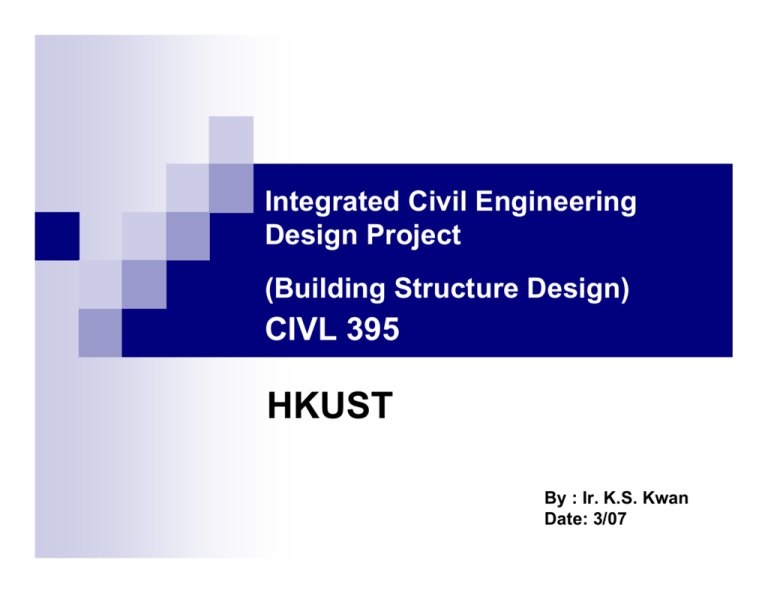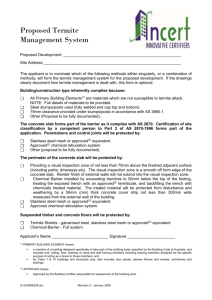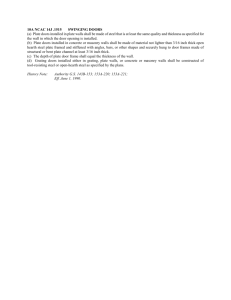Building Design_b
advertisement

Integrated Civil Engineering Design Project (Building Structure Design) CIVL 395 HKUST By : Ir. K.S. Kwan Date: 3/07 Content 1. Building Control in Hong Kong 2. Design Criteria 3. Structural Form (Residential Building) 4. Hong Kong Wind Loading 5. Computer Modeling 6. Design Example STRUCTURAL FORM for Residential Building •Tower •Podium Structure •Building adjacent to slope Lintel beam To identify the wall as structural element and link them together by lintel beam to provide sufficient lateral stiffness Wall Slab Slab Design – Concrete grade Grade 30 to 35 (too high concrete grade may lead to thermal crack during large pour of concrete) – Steel reinforcement percentage Design as HK CoP 2004 for structural use of concrete Average steel ratio is around 120~140 Kg/m3 – Preliminary slab size estimation About 100mm~400mm depending on the span of slab ( to minimize the number of different slab thickness, say 2 ~3 types, at typical floor for buildability consideration To consider the following loading – Self weight – Finishes (domestic area/toilet/kitchen) (25mm to 80mm thick) – Partition Slab is designed as one-way or two ways slab Wall Design – Concrete grade Grade 30, 40, 60 or more is commonly used. By using high strength concrete, it can optimize the wall thickness and increase the lateral stiffness of wall. The concrete grade will also be changed along the height of building e.g. from Grade 60 at lower floor to Grade 30 at top roof. The thickness will be trimmed down along the height of building e.g. from 400 at 1/F and gradually changed to 200 at top floor. The thickness will be changed every 10 ~20 storey to minimize the disturbance on construction. – Steel reinforcement percentage Design as HK CoP 2004 Average steel ratio is around 100~150Kg/m3 – Preliminary wall size estimation Gravity Load – by tributary method Wind Load – by simple computer model Vertical Element Gravity Load Estimation by Tributary Area Method 250 2625 200 2625 250 W2 200 W3 W1 W1 3900 C1 Plan 3-D TRIBUTARY AREA METHOD Assumption No. of storey = 20 Storey height = 2800 Slab thickness = 150 Beam size = 400x200 (ext.) Beam size = 450x250 (int.) Dead Load = 10KPa Live Load = 3KPa TRIBUTARY AREA METHOD (KN) 250 2625 200 2625 250 W2 200 C1 1686 W1 2264 W2 2568 W3 1266 W3 W1 W1 C1 Plan 3900 Lintel Beam Design (where linking shear Lintel Beam wall together to transmit wind shear force) – Size Width as wall thickness Depth controlled by headroom (min. under side of beam i.e. 2100 at door and 2300 under beam Concrete grade same as floor slab for easy concrete pour with slab or more if required – Steel reinforcement percentage Design as HK CoP 2004 Average steel ratio is around 120 ~160 Kg/m3 – Preliminary lintel size estimation Wind Load – by simple computer model; the size is always controlled by wind shear transmission (in some critical case, steel plate will be used to replace r.c. design to enhance the wind shear transmission) Gravity Load – by tributary method (not the controlled case) Steel plate at lintel beam Transfer Structure Tower (Shear Wall system) Podium (Plate Structure) Supporting Column (Rigid Frame) Transfer Girder Structure The behavior is similar to deep beam when the wall extending to columns such as case a, b & c. Transfer Plate Structure Shear Wall Structure at Tower above Transfer Plate Thick plate structure to support all wall structures above Column Structure below Transfer Plate Transfer Plate Transfer Structure Design (Plate or Girder) – Design similar to pilecap or beam – Closed column spacing under the transfer structure to allow truss effect at transfer structure to minimize the deformation of transfer structure (Prestressed transfer structure is required for large span ) – Steel reinforcement percentage Design as HK CoP 2004 Average steel ratio is around 240~280 Kg/m3 – Preliminary size estimation (1.5m ~5m) Depend on the spacing of columns and tower loading Gravity load – as the wall load transmitted tower load to plate level Wind load – the plate behaviour as frame structure integrated with columns below Normally, the thickness is controlled by shear stress Podium Structure Behavior Loading from tower including: (P) Axial Load (M) Moment (V) Shear Transfer Plate Design To cater for gravity load and wind load from tower structure including axial load, moment and shear The transfer plate with column below to form a rigid frame structure All loadings are transmitted to foundation by shear, moment and axial force. Transfer Plate with Prestressed Tendon Building Development Adjacent to Slope Retaining structure is required for building near the slope The extent of excavation will depend on the subsoil condition of slope i.e. Rock / Soil ?? ?? ? ?? ? ?? ? Building Development near Slope Walls at Tower Transfer Plate Column under transfer structure Large Diameter Bored Pile Pile Cap Retaining Wall Structure Pile Cap Retaining structure for semi-basement construction Retaining Wall Structure with deep excavation required Two levels basement to reduce the deep excavation HONG KONG WIND LOAD Wind Load Assessment Procedure Wind Responses of a Building • Static No movement • Equivalent Static Load Wind direction • WC 2004 • Dynamic - Along wind response • Gust Factor Method • WC 2004 - Cross wind response - Torsional wind response • Literature/ Wind Tunnel Test • WC 2004 Wind Load Assessment Procedure (1) Step 1 – Determine Method of Calculation • Determine method of calculation according to the signpost in Cl. 3.3 (p.2) and Cl. 7.6 (p.5). Method Signpost in Wind Code 2004 Characteristic I (i) fnatural > 1Hz; or (ii) H <= 5 x Min (B, D); and H <= 100m • No significant resonant dynamic response • Equivalent Static Load Method [Cl. 5, p.3] II (i) fnatural <= 1Hz; and (ii) H > 5 x Min (B, D); or H > 100m • Susceptible to along wind resonant response • Gust Factor Method [Cl. 7, p.4] III (i) • Susceptible to dynamic excitation • Recommendation from literature/ Dynamic wind tunnel test [App. A, p.7] Open frame with significant resonant dynamic response, or (ii) fnatural < 0.2Hz, or (iii) Significant cross wind / torsional resonant response To determine building height (H) and width (B,D) Building least horizontal dimension (B,D) Building height (H) B Building on plan To define the height and least dimension of building Sec A-A b A-A h H B B-B Sec B-B Wind Load Assessment Procedure (2) Steps 2 - 5 Step 2a Method 1 – Static Building Method 2 – Slightly Dynamic Building • Calculate Design Wind Pressure (3-sec. gust pressure) [Table 1, p.3] • Calculate Design Hourly Mean Wind Pressure [Table 2, p.5] 2b • Calculate Gust Response Factor (G) [Appendix F, p.19~21] 3 • Calculate Topography Factor [Appendix C, p.10~13] • Calculate Topography Factor [Appendix C, p.10~13] 4 • Calculate Force Coefficients (Cf) • Calculate Force Coefficients (Cf) – Height Aspect Factor, Ch – Shape Factor, Cs – Reduction Factor, RA [Appendix D, p.14~16] 5 • Calculate Total Wind Force F = Cf. Σ qz .Az [Eqn (1), p. 3] – Height Aspect Factor, Ch – Shape Factor, Cs [Appendix D, p.14~15] • Calculate Total Along-Wind Force F = G. Cf .Σ qz .Az [Eqn (3), p. 4] Step 2a – Design Wind Pressure/ Design Hourly Mean Wind Pressure • Wind Code 2004 – Only One Terrain • Open Sea Terrain Wind Profiles Below 200m Wind Pressure Profile Under 200m 250 1983 1983 (Stepwise) PNAP150 Height (m) 200 2004 150 100 50 0 0.00 1.00 2.00 3.00 Pressure (KPa) 4.00 5.00 Step 2b - Along Wind Dynamic Resonant Response by Gust Factor Method (1) • The original method was developed by Davenport (1967) and Vickery (1966 and 1971) • In Wind Code 2004, the equation is simplified to: 2 G = 1 + 2I h gv B + 2 g f SE ς (Refer to Wind Code 2004 Appendix F for description of the other variables) Step 2b - Along Wind Dynamic Resonant Response by Gust Factor Method (2) • Dynamic resonant response is dependant on the magnitude of the fluctuating load as well as its size (or scale) in relation to the size of the structure • The size reduction factor, S, accounts for the correlation of pressures over a building and is equal 1 to h/λ λ represents the size of the ⎡ 3.5na h ⎤ ⎡ 4na b ⎤ b/λ ⎢1 + ⎥ ⎢1 + ⎥ wind gust V V h h ⎦ ⎣ ⎦⎣ • The reduction factor, RA, in Table D3 (p.16) does not apply to the Gust Factor Method in Appendix F Step 3 – Topography Factor (1) • Wind Code 2004 – Speed up ratio adopted from BS6399-2:1995 except that the altitude factor in BS6399-2 was excluded (In BS6399-2, altitude factor is used to adjust the basic wind speed for the altitude of the site above seal level.) Step 3 –Topography Factor (2) Step 3 –Topography Factor (3) Step 3 –Topography Factor (4) Step 3 –Topography Factor (5) These examples are taken from British reference book based on British Code. Due to the different requirements in British Code and Hong Kong Code regarding the idealization of the hill/slope, the actual hill/slope shall be differently idealized under the two Codes. These examples from British were for illustration only and the method of idealizing the hill/slope should not be copied for application to Hong Kong Code. Step 3 –Topography Factor (6) Step 3 –Topography Factor (7) Comment: Idealized slope (a) may be more appropriate for Hong Kong Code. Topography Factor (App. C of HK Wind Code) Forces on Buildings 1. Total Force on a Building F = Cf Σ qz Az where Cf = force coefficient qz = design wind pressure at height z Az = effective projected area of that part of the building corresponding to qz 2. The effective projected area of an enclosed building shall be the frontal projected area 3. The effect projected area of an open framework building shall be the aggregate projected area of all members on a plane normal to the direction of the wind 4. Each building shall be designed for the effects of wind pressures acting along each of the critical directions Force Coefficeints A. For Enclosed Building a) Cf = Ch x Cs b) From other international codes accetped by BA c) For building with isolated blocks projecting above a general roof level, individual force coefficients corresponding to the height and shape of each block shall be applied. d) For building composed of similar contiguous structures separated by expansion joints, the force coefficients shall be applied to the entire building. Height Aspect Ratio Ch Height Breadth Height Aspect Factor Ch 1983 2004 1.0 or less 0.95 0.95 2.0 1.0 1.0 4.0 1.05 1.05 6.0 1.1 1.1 10.0 1.2 1.2 20.0 and over - 1.4 Remark: Linear Interpolation to obtain intermediate values Shape Factors Cs for Enclosed Building b/d Cs 1.0 or less 1.0 2.0 1.1 3.0 and over 1.3 Plan Shape Rectangular d wind b Cs for buildings with closed spacing b d Remark: Interpolate linearly Shape Factors Cs for Enclosed Building Plan Shape Cs Circular wind Other Shapes 0.75 Cs for the Respective enclosing rectangular shape in the direction of the wind Note: When the actual shape of a building renders it to become sensitive to wind acting not perpendicular to its face, the diagonal wind effects and torsional wind effects should be considered Reduction Factor RA • Gusts are the results of eddies and vortices • The speed of gust is a function of its duration • The smaller the size of the gust, the shorter will be its duration and the higher will be the gust speed • The larger the size of gust, the longer will be its duration and the lower the average gust speed • A small gust can only create high wind loading on a small local area of the structure • The whole structure should be designed with the speed of a gust which is just big enough to affect the whole structure simultaneously • A 3 second gust can normally engulf a building with frontal area of 300 to 800m2, a longer duration gust is required to be effective on the whole of the structure • A reduction factor is therefore applied when designing buildings of larger dimensions (E.C.C.Choi – Commentary on 1983 wind codes) • Not applicable for buildings with significant resonant dynamic response designed by using hourly mean wind pressure Reduction Factor RA for Enclosed Buildings Frontal Projected Area m2 Reduction Factor RA 2004 500 or less 1.00 800 0.97 1000 0.96 3000 0.92 5000 0.89 8000 0.86 10000 0.84 15000 and over 0.80 Note : Linear Interpolation may be used to obtain intermediate values • Wind Load Case – X & Y directions are commonly accepted – Additional wind direction (e.g. diagonal wind for Y-shape building) is required – For large frontal area building (say >50m), additional torsional wind load (10% of long face dimension) is required Wind Load Distribution at Building Wind Load Calculation as HK CoP (Building is considered as significant resonant dynamic structure) Wind load calculation at each floor for a building with 40 storey (with 3 floors above domestic floor) and the building width is 40.23m Building structure as significant resonant dynamic structure \ Sa=topography factor Wind Load Calculation as HK CoP (Building is not considered as significant resonant dynamic structure) Wind load calculation at each floor for a building with 40 storey (with 3 floors above domestic floor) and the building width is 40.23m Building structure not considered as significant resonant dynamic structure (Note: Total wind shear is larger based on static wind load approach for building aspect ratio just greater than 5) Sa = topography factor COMPUTER MODELING Common Structural Analysis Software used in Hong Kong GSA STARIII GTSTRUDL PAFEC STAN ETABS SAP2000 SAFE SADS Tall Building Modelling Assumptions 1. Material – All structural components behave linearly elastically. 2. Participating Components – only the primary structural components participate in the overall behaviour 3. Floor slabs – Floor slab are assumed to be rigid in plane unless they contain large openings or are long and narrow in plan Only the primary structural components are put in model Rigid in plane Tall Building Modelling Assumptions 4. Negligible stiffness – component stiffness of relatively small magnitude are assumed negligible 5. Negligible deformations – deformations that are relatively small and of little influence are neglected. 6. Cracking – the effects of cracking in reinforced concrete members to flexural tensile stresses may be represented by a reduced stiffness This line should be a straight line in assumption due to the small deformation V How to apply wind loading in computer model? In common building shape with the rigid diaphragm assumption, the wind load should be applied at the geometry centre of each floor Wind load applied at floor Wind load applied at centre of frontal area What can you find in computer modeling? – Seismic, wind and gravity analysis – Deformation of building under different loading conditions – Member force under different loading conditions Deflection of building at top floor including the X & Y displacement and Z direction rotation Q&A If you have any questions about the structural design, please forward email (with your Name and Student ID no.) to : akskwan@gmail.com







